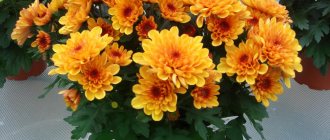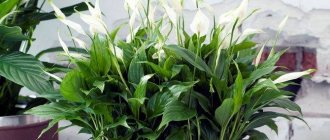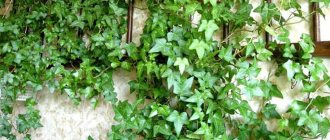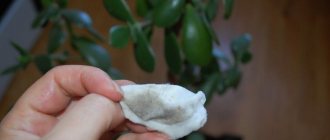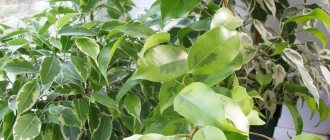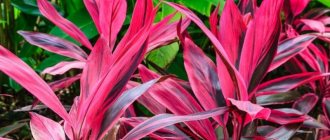Aglaonema
The flower belongs to the Araceae family. Its homeland is hot countries: Africa and India. In summer, aglaonema is demanding of watering, but in winter it will quite appreciate moderate soil moisture. The plant itself looks attractive; in most species, the oblong leaves are painted with a patterned pattern in the form of stripes or spots. It rarely blooms indoors, only sometimes producing an inflorescence (cob) in the summer. Several bright berries will ripen for six months, or even longer. Varieties with brightly colored leaves are demanding of light: in the shade they will change their color to faded. In the spring, the plants are transplanted into a nutritious soil mixture of leaf and turf soil, as well as rotted manure and river sand (2:2:2:1). Aglaonema will happily feed on natural calcium: bone meal. Add a handful of flour to the soil mixture.
Aglaonema. Photo: Commons.wikimedia.org
Aspidistra
Alex maschtakov / Shutterstock
Unlike spathiphyllum, aspidistra also hardly blooms: if you are lucky, in the summer it will produce one flower for one day. Aspidistra leaves are thin and long. Do not be alarmed if there are spots or stripes on them: these are not signs of illness, but a variant of the norm. Another important detail is that aspidistra has many roots, so it needs a large pot.
How to care
Light . Aspidistra feels great even in the shade, so it can be placed in the far corner. But it is better to hide it from direct sunlight.
Water . You can water the aspidistra only when the top layer of soil is dry. Two to three times a week in the warm season, once a week in the cold season.
Transplant . Preferably no more than once every three years. The thing is that it has a fragile root system, which can easily be damaged during the process of “emigration” from the pot.
What else do you need to know . Get rid of withered, yellowed leaves: this will not only help maintain the neat appearance of the plant, but will also make the aspidistra healthier. Cut them off at the very root.
Bilbergia
Belongs to herbaceous evergreens. It is an epiphyte, that is, in natural conditions it attaches to a tall tree to reach the upper tier, where there is a greater flow of sunlight. At the same time, Billbergia is not a parasite; it does not feed on the juices of the host on which it grows.
Over 50 species of Billbergia are bred in indoor floriculture. The most unpretentious of them is Billbergia drooping. Its leaves are thin, and its flower stalks lower their heads straight to the ground, which is why the plant got its name. B. Sanders has matte, slightly powdery leaves. U b. The striped leaves are folded into characteristic funnels and have whitish transverse stripes on the underside.
Billbergia is grown in peat. Considering the structural features of its root system and its ability to attach itself to a tree, it is clear that it will not need a large container. Flower growers grow it in small containers filled with peat. The main thing is not to overdo it with watering. Moisten the soil only as the lump dries completely, otherwise the roots will not be able to withstand overwatering and will begin to rot.
Bilbergia. Photo: Commons.wikimedia.org
Schlumbergera, or Zygocactus
Dyfrain / Shutterstock
This is also a cactus, but it is very different from the others both in appearance (it has no thorns at all) and in the rules of care. This plant is also called Decembrist and Christmas cactus because it is covered with red or pink flowers in winter - in December or January.
How to care
Light . Unlike other cacti, Schlumbergera is very susceptible to direct sunlight, so it cannot be placed on a windowsill or balcony. But if the place is slightly shaded, it’s not scary.
Water . Schlumbergera needs to be watered regularly: once or twice a week. Additionally, you can moisten the plant using a spray bottle.
Transplant . First once a year, and then every three to four years. The flower needs an annual transplant - preferably at the end of February, after flowering has ended.
What else do you need to know . To prevent Schlumbergera from growing excessively, at the beginning of summer you can remove the shoots, but without using scissors: just unscrew the excess with your fingers. After this procedure, the shape of the plant will improve and it will bloom even more abundantly.
Dracaena
In common people it is called cordilina. Meanwhile, the decorative deciduous perennial has a woody stem and linear leaves and has nothing to do with cordyline. Most often, flower growers grow D. derema and D. fragrant indoors. Dracaena derema looks decorative due to its spectacular variegated leaves. But this beauty is demanding of conditions. And find a bright place for it, maintain a high temperature, and also provide humid air.
Dracaena fragrant, unlike Deremsky, is undemanding to living conditions. The desired composition of the soil mixture for it consists of turf, leaf, humus and peat soil, as well as sand (3: 1: 1: 1: 1). It also does not need high air humidity.
In nature, D. fragrant grows up to 6 m, but when grown at home in pots - much less. Cream flowers have a simple perianth. The aroma is so pleasant and strong that insects and small birds like hummingbirds flock to it. After flowering, a fruit appears on the plant: an orange-red berry.
Where does dracaena come from? More details
The most unpretentious indoor plants
13 most unpretentious perennials
Perennial flowers live in the garden for a long time, delight with their greenery soon after the snow melts, bloom earlier and are usually quite frost-resistant. However, perennials generally require less care than annual plants.
Read more
There are many wonderful indoor plants to suit all tastes and needs, and from time to time one or another becomes very popular. But it is not a fact that these plants can be successfully grown in your conditions. It’s better to choose the most unpretentious plants, they won’t let you down! These are plants that tolerate dryness and high temperatures in the apartment in winter, the presence of dust, and also tolerate shading; their care is minimal. At the same time, unpretentious plants are very beautiful, among them there are many flowering plants and plants with decorative foliage.
Well, the choice is very large:
Chlorophytum comosum 1. Chlorophytum crested (sedge)
This is the first number in our hit parade of the most unpretentious plants. This is who is truly capable of growing practically without our “participation”! Chlorophytum tolerates dry air and high indoor temperatures well. It is not very demanding on lighting - it loses its decorative effect only in a very dark place. There is no need to water it often, and chlorophytum is practically not affected by diseases. Without requiring special care, this amazing plant cleanses the atmosphere of the apartment from harmful impurities and electromagnetic radiation day and night. Its curved leaves form a beautiful wide rosette, and on long peduncles daughter rosettes grow from time to time, which can be rooted.
Abutilon 2. Abutilon (indoor maple)
An unpretentious plant and at the same time a wonderful dominant in the interior. Abutilon blooms spectacularly: its large flowers are bell-shaped. Its leaves are similar to maple, and its flowers are very striking. They come in different colors: white, pink, yellow, red. Abutilon tolerates dryness and heat in the apartment, and you can place a pot with this plant either on the windowsill or at some distance from it. You need to water little - otherwise it won’t bloom. Abutilon is fertilized rarely - once every three weeks with liquid fertilizer for indoor flowers. Abutilone creates a favorable climate in the room: it purifies and moisturizes the air. However, this unpretentious plant requires space, so it is better to place it in a large room.
Hibiscus 3. Hibiscus (Chinese rose)
The plant is a spreading bush with huge cup flowers, most often red, with a long pistil. However, the plant has many varieties, some with white and pink flowers, and even speckled ones! Hibiscus blooms all year round and loves exactly the same temperature and humidity as in our apartments in winter. But he needs light, so his place is on the windowsill. It is necessary to water frequently and feed regularly, especially in winter, so that the buds do not fall off.
Fuchsia 4. Fuchsia
Fuchsia is a flower in the “English” style, associated with English interiors and classics. This is a subshrub with woody shoots at the bottom. Fuchsia grows and blooms well in light, but not sunny places (not on the windowsill, but at some distance from it), with abundant watering. The main thing is that the plant tolerates dry air. But in winter, keep fuchsia on the windowsill, since in winter it needs relative coolness. Feed the plant once a week. In the summer, you can take fuchsia to the dacha and keep it as a container plant. It is imperative to monitor fuchsia: sometimes it can be affected by spider mites.
5. Balsam
Previously, this flower was called “touch-me-not”, because at the slightest touch its seeds “shot out” far around the plant. Appearance – compact bush blooming with red or pink flowers. Moreover, the older the plant, the more abundantly it blooms. There are varieties with variegated leaves. Balsam is very easy to care for. This flower prefers partial shade and tolerates dry air; its only requirement is abundant watering. Also, balsam loves periodic spraying, only in this case you need to avoid getting water on the open flowers. In severe frosts, when the air in the apartment is especially dry, whiteflies may attack the plant.
begonia 6. Begonia
A beautiful flowering plant as if specially created for shaded areas in the apartment. But begonia does not like bright light. There are many varieties of begonia that not only bloom profusely, but also have spectacular variegated leaves. Begonias tolerate both heat and coolness equally well; they are also undemanding to the soil. Pests, as a rule, do not attack begonia. But they need high air humidity, but it is not advisable to spray them: the leaves do not tolerate contact with water well. Therefore, it is better to use a humidifier or place a tray with wet pebbles on the radiator. Begonia roots should not dry out - the plant needs regular watering. In the summer, begonia can be transplanted into a flower bed in the garden.
Fatsia japonica 7. Japanese Fatsia
Even if it seems that your conditions are completely unsuitable for indoor flowers, feel free to plant Japanese Fatsia . This is a shade-tolerant plant, resistant to diseases and pests, with beautiful large leaves similar to chestnut leaves. And even near central heating radiators she feels fine. At the same time, it increases air humidity well, promotes good sleep, and heals the heart and lungs. Fatsia is an energy “donor”, so we will feel a surge of strength after spending some time in the room where she grows.
pelargonium 8. Pelargonium
This flower is mistakenly called geranium by many. On a sunny windowsill they can bloom all year round with red, crimson, white or pink inflorescences. There are species with fragrant leaves. Pelargonium tolerates dry air well, and it requires moderate watering; on the contrary, waterlogging is the plant’s main enemy. In the summer, pelargonium can be moved to the garden as a container plant or transplanted into a flower garden, and returned to the apartment in the fall.
There are indoor plants in every home. Some people choose violets, others hibiscus. And our expert Oktyabrina Ganechkina shares tips on how to grow beautiful fuchsia!
ivy 9. Climbing indoor plants : ivy, passionflower, philodendron and cissus
These are very unpretentious and decorative vines; they tolerate the peculiarities of the microclimate in a city apartment. Ivy has many varieties, so its leaves can be triangular, lobed, or oval, and the color varies from simple green to a combination of green with white, cream, gray and yellow. Ivy tolerates dry air, but spraying will not hurt it. Cissus belongs to the grape family, has a woody stem, and its leaves are medium in size. It is the most resistant to dry air and tolerates dust well. Passionflower blooms beautifully, the leaves are palmate and medium-sized. Philodendron has elongated leaves and requires periodic spraying just like ivy. All these plants have a pronounced relaxing effect not only due to their energetic effects, but also due to the special substances they secrete.
Dracaena 10. Dracaena
Dracaena resembles a palm tree, but is not related to real palm trees. This is a very stylish and unpretentious plant with its own “secrets”. There are many types of dracaenas, and some of them can withstand even strong shading and negligence in care. She really likes harmful impurities, she absorbs them with pleasure, but this is not the main thing - she is able to “delay” many of our ailments, headaches, for example, and not only. It seems to “get used” to a person, and over time it comes into more and more energy contact with him, enhancing its healing effect.
Ficus 11. Ficus The ficus family can offer a wide variety of representatives for rooms.
First of all, we can recommend Ficus Benjamin, Ficus rubber, Ficus lyre. These varieties are unpretentious, successfully neutralize harmful impurities from the surrounding air, and are suitable for most interior styles. But there is one more feature - their strong energy, which a person can feed on during sleep. Moreover, this energy is special, “soft” - it relieves fuss and nervousness, and a feeling of comfort and coziness appears.
Palm trees 12. Palm trees
They are also unpretentious, the only thing is that they still require good lighting. But there is an opportunity to place them closer to the window - a great option. I would especially like to highlight the Howea Forster palm, the Canarian date and the graceful Hamedorea (mountain palm). They will fill and “revive” any dull corner of the room; their graceful feathery leaves add lightness, airiness, and ease to the atmosphere. They refresh the air and, like ficuses, “feed” energy. They can be placed in “ethnic” containers, the soil near the trunk can be decorated with stones, shells, etc. In general, any interior experiments are appropriate with palm trees.
Spathiphyllum 13. Spathiphyllum
The modest and elegant spathiphyllum periodically blooms without any tricks on our part. Outwardly, it is very similar to a white calla lily. The flower is shade-tolerant and does not require special care, but it does not like excessive waterlogging of the soil - the roots can rot. The plant perfectly humidifies the air.
aloe vera 14. Aloe vera (the so-called “agagave”)
This plant is a succulent and is absolutely undemanding to growing conditions. The only thing that is important for aloe is light, so you shouldn’t place it far from the window. Watering in summer should be as the soil dries, and in winter - once a month. Aloe is a medicinal plant, and therefore it is worth having at least one copy.
Sansevieria 15. Sansevieria (or “pike tail”, or “mother-in-law’s tongue”)
This plant is, as they say, indestructible. There are no problems with watering, or with the choice of soil, or with fertilizing, or with dust - the plant is a succulent. Again, a champion in air purification and neutralization of computer radiation. His spectacular “swords” can be single-colored, striped, or variegated. Sansevieria is especially good “solo”: about 8-10 plants in an appropriate container and substrate, decorated with pebbles or pebbles - that’s something!
Callisia fragrans 16. Fragrant callisia
It is also called “golden mustache” or “indoor ginseng”. This is an ornamental foliage plant, similar in appearance to young corn. In addition to elongated leaves, callisia forms long shoots with articulations similar to joints. When 9 or more “joints” grow on one shoot, they acquire a purple hue and become medicinal. Such shoots can be cut and used for tinctures and decoctions. By the way, these shoots are especially good for treating joint diseases. Isn’t that why it’s such a figurative coincidence? Callisia grows under any conditions, even in close proximity to central heating radiators, and is very easily propagated by rooting the cut top. Sometimes, however, you need to wipe off dust from its leaves.
Neomarika (marika)
The plant belongs to the Iris family. The homeland is considered to be Brazil, Africa, Central and South America. For its special beauty, the flower was named in honor of the ancient Roman nymph Marica, who gave birth to the future king Latinus from Faun.
The plant is very similar to the iris with its long leaves and flowers. The leaves have a lanceolate shape, and the flowers are located at the ends of the arrows. But the flower will not be happy for long, about one day, and will immediately wither. However, a baby is formed in its place. It begins to grow slowly, and the peduncle cannot withstand such weight; it gradually bends towards the ground. Such a cunning scheme is nothing more than transportation to the place of further growth of the baby. Now the young plant will take root and begin an independent life, but all this will happen close to the parent. For such an interesting feature, this iris was nicknamed “walking”.
To grow indoors, the flower will require a special wintering at low temperatures, not higher than +8 degrees Celsius. This is the only way it can bloom. The flower is propagated by dividing rhizomes and seeds. The best soil composition for it is turf, peat and sand (2:3:1).
Neomarika. Photo: Commons.wikimedia.org
Crassula (crassula, money tree)
The same study shows that Crassula also does an excellent job of humidifying the air. The process of evapotranspiration (evaporation of moisture into the atmosphere) in this plant occurs in the dark, which makes it an indispensable assistant in the months when daylight hours become short. Crassula loves light, so it is better to keep it near windows. It needs a lot of watering in spring and summer, but in fall and winter you should let the soil dry out completely before watering again.
Cissus cactus
This plant comes from Asia, where the tropics are hot and warm. Therefore, he will just like the dry air in the room. The name “cactus-like” was given to it for its appearance: it is a real succulent. The liana consists of many articulated tetrahedral stems, the leaves are very small, and the internodes are decorated with small tendrils, with the help of which the plant conquers new spaces.
Because of the tetrahedral stems, cissus is popularly called quadrangular.
In winter, the plant is hardly watered; they find a cool room for it, where the temperature does not rise above +10 degrees Celsius, or they simply shade it on the windowsill and protect it from the hot air of the room.
Cissus. Photo: Commons.wikimedia.org
Echinocactus, Echinopsis, Cleistocactus and other cacti
These small, thorny plants are inexpensive, look unusual and are generally unpretentious. Even if you completely forget about them for a couple of weeks, nothing will happen to them.
septima/Shutterstock
How to care
Light . In nature, cacti grow in warm, sunny places, so you need to find an appropriate corner for the indoor plant. This could be a cabinet, shelf, table on which the sun falls, or even a windowsill. They are not afraid of direct rays. In winter, it is better to provide cacti with additional lighting.
Water . Water the cactus only when the soil is completely dry. In summer - once a month, and in winter, if the house is not too hot, even less often - once every two or three months. Do not water too often or abundantly: the roots may rot.
Transplant . A cactus that is no more than four years old - once a year. Then less often. The main thing is to remember to protect your hands from needles!
What else do you need to know . Choose a cactus pot with drainage holes only. It is better to take an unglazed ceramic container: moisture evaporates well from it, and heat is retained inside.
Ficus elastica
The plant of the Mulberry family contains milky sap. Many species were formerly called rubber trees. From the tall giants, growing up to 40 m, rubber is extracted, which is used to make car tires.
However, for landscaping rooms they use a low variety: f. decor elasticity. This plant does not have a tendency to branch and does not grow higher than 150 cm. The leaf blades of the ficus are greenish-brown in color, they are dense and wide, sitting on short reddish petioles.
Sometimes in winter the ficus suddenly begins to shed its leaves.
This “leaf fall” is associated with the overflow of the plant. Experienced gardeners do not water the ficus at all in winter, but only occasionally spray the plant. Ficus rubbery, or ficus elastica. Photo: Commons.wikimedia.org
Clivia
PQK / Shutterstock
Young clivia pleases the eye with a beautiful orange or yellow head of flowers once a year, and an older plant twice as often.
How to care
Light or shadow . Keep clivias out of direct sunlight, but not in complete shade.
Water . When clivia blooms, it needs to be watered frequently—several times a week—with warm water. It is important to ensure that water does not accumulate in the pan. And during the dormant period, the plant does not need to be watered at all.
Transplant . There is no need to replant clivia: this may disturb the plant and affect its health.
What else do you need to know . From November to February, clivia needs to be provided with a period of rest: put it in a cooler place and stop watering. Check its condition periodically: if the clivia begins to shed its leaves, it does not have enough water, water it, but just a little.
Epipremnum aureus
Epipremnum is also sometimes called devil's ivy for its amazing vitality. Even if you forget to water it and leave it in the shade, it will survive it. But if you intend to take care of this plant, then place it in a well-lit place (just not in direct sunlight - they are dangerous for it) and water it generously. Let the soil dry out between waterings. Like the peace lily, keep it away from animals.
How plants adapt to dry air
Many plants, especially those native to arid climates or those where they are exposed to long periods of drought, have developed ways to compensate for dry air. Cacti and succulents are usually very tolerant of dry air, as are some epiphytic plants such as hoya.
Some plants resist dry air by producing leaves with fewer stomata than usual, thereby reducing water loss. Many have left their leaves altogether and breathe green stems (for example, cacti). Others keep their mouths closed during the day, when the sun is hottest and water loss is greatest, breathing only at night. In other words, they hold their breath 12 hours a day! In addition, plants that are tolerant of dry air often have very thick leaves or leaves coated with wax, powder, or hair to reduce evaporation.
